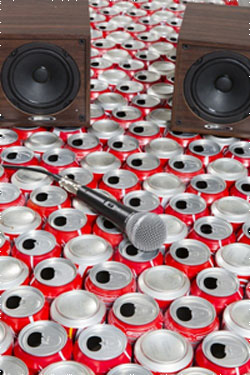What does happen when one blows in a soda can? An almost pure tone is generated, a signature that it resonantly interacts with audible sound. At a different scale, a similar phenomenon occurs when a light wave interacts with a material. The interaction depends on two criteria: the chemical composition of the material, and its atomic structure.
Researchers from the Institut Langevin (ESPCI ParisTech, CNRS) have developed an original experiment based on honeycomb arrangements of soda cans to create an acoustic superlens. Their work was published in the renowned Nature journal on september 4th, paving the way for new research in the field of composite materials.

Photography of the honeycomb arrangements of “acoustic atoms”, ie. the soda cans (© Institut Langevin, BENJAMIN BOCCAS)
In the last 30 years, new composite materials emerged, each class of which referring to one of the elementary parameters of matter: photonic crystals based upon the organization of matter, and metamaterials with properties related to their chemical composition. These two families had always been considered clearly separated, until now. Indeed, unlike photonic crystals, metamaterials are organized at a scale far below their wavelength response, so that scientists were admitting that their structure could not modify the propagation of waves. In their work, Kaina et al. have demonstrated that metamerials with adapted structures can exhibit properties of crystal structures. They evidenced that multiple scattering can occur on small scales, thus highlighting the profound implications of metamaterials spatial structure.
Researchers proposed a striking demonstration of their findings, by revisiting the concept of negative index metamaterials. The idea is to observe a wave propagating from a middle to another (like a ray of light entering water for example), and to notice that the refracted signal is directed on the other side of the normal to the middle.
Their theoretical and numerical predictions were finally confirmed by an elegant acoustic experiment using.... soda cans.
Scientists actually designed a soda cans made metamaterial, organized on a honeycomb scheme, and effectively presenting a negative index of refraction over a certain frequency range. The French team lead by G. Lerosey takes advantage of this property to demonstrate the first acoustic superlens based on negative index metamaterials that effectively beats the diffraction limit.
Given the general theoretical approach, this work will allow the study any type of waves, and also inspire both research on metamaterials and photonic crystals.
Contact author: Geoffroy Lerosey – geoffroy.lerosey at espci.fr
(doi:10.1038/nature14678)